Enhancing Gain for UWB Antennas Using FSS: A Systematic Review
Abstract
:1. Introduction
- To the best of the authors’ knowledge, this is the first review article that looks into the ability of FSS to enhance and stabilize the gain for UWB antennas with a new direction to provide FSS miniaturization.
- Systematically reviews the development of gain enhancement techniques using FSS as a reflector for UWB applications.
- Maps associated studies into a comprehensible taxonomy, apart from highlighting the methods, theories, and enhancement analysis models used.
- The benefits and drawbacks of numerous research structures on both conventional and advanced gain improvement methods are marked with many articles’ references to provide a clear picture for interested researchers to further prod into the design of UWB planar antennas.
2. Systematic Literature Review Characterization and Queries
3. Literature Taxonomy on Gain Enhancement Techniques Using FSS
3.1. FSS Single-Layer Reflectors
3.2. FSS Multi-Layer Reflectors
4. New Directions
- The FSS reflector size should be sufficiently large to be able to reflect all incident waves emitted from the radiator (antenna). A high reflective sheet can enhance the gain.
- The coming incident waves must be in-phase with the ongoing waves from the FSS unit cells to achieve a linearly decreasing phase.
- The gap between the radiator and FSS reflector is integral. A comfortable response with high performance can be obtained at a distance of 10 mm.
- The type of substrate is another imminent factor. This is because a high dielectric constant value is preferred for FSS reflector miniaturization.
5. Conclusions
Author Contributions
Funding
Institutional Review Board Statement
Informed Consent Statement
Data Availability Statement
Conflicts of Interest
References
- Anwar, R.; Mao, L.-F.; Ning, H. Frequency Selective Surfaces: A Review. Appl. Sci. 2018, 8, 1689. [Google Scholar] [CrossRef] [Green Version]
- Al-Gburi, A.J.A.; Ibrahim, I.M.; Ahmad, K.S.; Zakaria, Z.; Zeain, M.Y.; Abdulhameed, M.K.; Saeidi, T. A miniaturised UWB FSS with Stop-band Characteristics for EM Shielding Applications. Prz. Elektrotech. 2021, 1, 142–145. [Google Scholar] [CrossRef]
- De Brito, A.C.R.; De Abreu, A.S.; D’Assunção, A.G.; Peixeiro, C. Effects of an FSS reflector on a microstrip line fed bow-tie slot antenna. J. Microw. Optoelectron. Electromagn. Appl. 2020, 19, 309–326. [Google Scholar] [CrossRef]
- Al-Gburi, A.J.A.; Ibrahim, I.; Abdulhameed, M.K.; Zakaria, Z.; Zeain, M.Y.; Keriee, H.H.; Nayyef, N.A.; Alwareth, H.; Khaleel, A.D. A compact UWB FSS single layer with stopband properties for shielding applications. Prz. Elektrotech. 2021, 1, 165–168. [Google Scholar] [CrossRef]
- Al-Gburi, A.J.A.; Ibrahim, I.B.M.; Zakaria, Z.; Ahmad, B.H.; Bin Shairi, N.A.; Zeain, M.Y. High Gain of UWB Planar Antenna Utilising FSS Reflector for UWB Applications. Comput. Mater. Contin. 2022, 70, 1419–1436. [Google Scholar] [CrossRef]
- Federal Communications Commision. First Report and Order: Revision of Part 15 of the Commission’s Rules Regarding Ultra-Wideband Transmission Systems; FCC: Washington, DC, USA, 2002. [Google Scholar]
- Best, S.R. A discussion on the significance of geometry in determining the resonant behavior of fractal and other non-Euclidean wire antennas. IEEE Antennas Propag. Mag. 2003, 45, 9–28. [Google Scholar] [CrossRef]
- Best, S.R. Operating band comparison of the perturbed Sierpinski and modified Parany gasket antennas. IEEE Antennas Wirel. Propag. Lett. 2002, 1, 35–38. [Google Scholar] [CrossRef]
- Guariglia, E.; Silvestrov, S. Fractional-Wavelet Analysis of Positive definite Distributions and Wavelets on D′(C). In Engineering Mathematics II; Springer: Cham, Switzerland, 2016; pp. 337–353. [Google Scholar]
- Guariglia, E. Entropy and Fractal Antennas. Entropy 2016, 18, 84. [Google Scholar] [CrossRef]
- Guariglia, E. Harmonic Sierpinski Gasket and Applications. Entropy 2018, 20, 714. [Google Scholar] [CrossRef] [Green Version]
- Krzysztofik, W.J. Fractal Geometry in Electromagnetics Applications-from Antenna to Metamaterials. Microw. Rev. 2013, 1, 19. [Google Scholar]
- Hohlfeld, R.G.; Cohen, N. Self-Similarity And The Geometric Requirements For Frequency Independence In Antennae. Fractals 1999, 7, 79–84. [Google Scholar] [CrossRef]
- Keriee, H.H.; Rahim, M.K.A.; Nayyef, N.A.; Zakaria, Z.; Al-Gburi, A.J.A.; Al-Dhief, F.T.; Jawad, M.M. High gain antenna at 915 MHz for off grid wireless networks. Bull. Electr. Eng. Inform. 2020, 9, 2449–2454. [Google Scholar] [CrossRef]
- Ibrahim, I.M.; Al-gburi, A.J.A.; Zakaria, Z.; Bakar, H.A. Parametric Study of Modified U-shaped Split Ring Resonator Structure Dimension at Ultra-Wide-band Monopole Antenna. J. Telecommun. Electron. Comput. Eng. 2018, 10, 53–57. [Google Scholar]
- Al-Gburi, A.J.A.; Ibrahim, I.M.; Zakaria, Z. An Ultra-Miniaturised MCPM Antenna for Ultra-Wideband Applications. J. Nano Electron. Phys. 2021, 13, 5012. [Google Scholar]
- Haider, A.; Rahman, M.; Ahmad, H.; NaghshvarianJahromi, M.; Niaz, M.T.; Kim, H.S. Frequency-Agile WLAN Notch UWB Antenna for URLLC Applications. Comput. Mater. Contin. 2021, 67, 2243–2254. [Google Scholar] [CrossRef]
- Al-Gburi, A.J.A.; Ibrahim, I.M.; Zakaria, Z.; Zeain, M.Y.; Alwareth, H.; Ibrahim, A.M.; Keriee, H.H. High Gain of UWB CPW-fed mercedes-shaped printed monopole antennas for UWB applications. Prz. Elektrotech. 2021, 5, 70–73. [Google Scholar]
- Al-Gburi, A.J.A., I; Ibrahim, M.; Zakaria, Z. Band-notch effect of U-shaped split ring resonator structure at ultra wide-band monopole antenna. Int. J. Appl. Eng. Res. 2017, 12, 4782–4789. [Google Scholar]
- Jan, N.A.; Kiani, S.H.; Muhammad, F.; Sehrai, D.A.; Iqbal, A.; Tufail, M.; Kim, S. V-Shaped Monopole Antenna with Chichena Itzia Inspired Defected Ground Structure for UWB Applications. Comput. Mater. Contin. 2020, 65, 19–32. [Google Scholar]
- Narayan, S.; Jha, R.M. A novel metamaterial FSS-based structure for wideband radome applications. Comput. Mater.Contin. 2013, 37, 97–108. [Google Scholar]
- Askari, H.; Hussain, N.; Choi, D.; Abu Sufian, M.; Abbas, A.; Kim, N. An AMC-Based Circularly Polarised Antenna for 5G sub-6 GHz Communications. Comput. Mater.Contin. 2021, 69, 2997–3013. [Google Scholar] [CrossRef]
- Liu, C.; Bai, Y.; Jing, L.; Yang, Y.; Chen, H.; Zhou, J.; Zhao, Q.; Qiao, L. Equivalent energy level hybridisation approach for high-performance metamaterials design. Acta Mater. 2017, 135, 144–149. [Google Scholar] [CrossRef]
- Moher, D.; Liberati, A.; Tetzlaff, J.; Altman, D.G.; Prisma Group. Preferred reporting items for systematic reviews and meta-analyses: The PRISMA statement. Ann. Intern. Med. 2009, 151, 264–269. [Google Scholar] [CrossRef] [Green Version]
- Hwang, G.-J.; Tu, Y.-F. Roles and Research Trends of Artificial Intelligence in Mathematics Education: A Bibliometric Mapping Analysis and Systematic Review. Mathematics 2021, 9, 584. [Google Scholar] [CrossRef]
- Knobloch, K.; Yoon, U.; Vogt, P.M. Preferred reporting items for systematic reviews and meta-analyses (PRISMA) statement and publication bias. J. Cranio-Maxillofac. Surg. 2011, 39, 91–92. [Google Scholar] [CrossRef]
- Fernández-Martín, F.-D.; Romero-Rodríguez, J.-M.; Gómez-García, G.; Navas-Parejo, M.R. Impact of the Flipped Classroom Method in the Mathematical Area: A Systematic Review. Mathematics 2020, 8, 2162. [Google Scholar] [CrossRef]
- Bhandari, M.; Morrow, F.; Kulkarni, A.V.; Tornetta, P., III. Meta-analyses in orthopaedic surgery: A systematic review of their methodologies. JBJS 2001, 83, 15. [Google Scholar] [CrossRef]
- Vankúš, P. Influence of Game-Based Learning in Mathematics Education on Students’ Affective Domain: A Systematic Review. Mathematics 2021, 9, 986. [Google Scholar] [CrossRef]
- Stewart, L.A. Cochrane Working Group On Meta-Analysis Using Individual Patient Data Practical methodology of meta-analyses (overviews) using updated individual patient data. Stat. Med. 1995, 14, 2057–2079. [Google Scholar] [CrossRef]
- Trentini, G.V. Partially reflecting sheet arrays. IRE Trans. Antennas Propag. 1956, 4, 666–671. [Google Scholar] [CrossRef]
- Vardaxoglou, J.C. Frequency Selective Surfaces: Analysis and Design; Research Studies Press: Boston, MA, USA, 1997. [Google Scholar]
- Costa, F.; Monorchio, A.; Manara, G. An overview of equivalent circuit modeling techniques of frequency selective surfaces and metasurfaces. Appl. Comput. Electromagn. Soc. J. 2014, 29, 960–976. [Google Scholar]
- Cox, A.J.; Dibble, D.C. Nondiffracting beam from a spatially filtered Fabry-Perot resonator. J. Opt. Soc. Am. A 1992, 9, 282–286. [Google Scholar] [CrossRef]
- Wang, N.; Li, J.; Wei, G.; Talbi, L.; Zeng, Q.; Xu, J. Wideband Fabry–Perot Resonator Antenna With Two Layers of Dielectric Superstrates. IEEE Antennas Wirel. Propag. Lett. 2014, 14, 229–232. [Google Scholar] [CrossRef]
- Feresidis, A.; Vardaxoglou, J. High gain planar antenna using optimised partially reflective surfaces. IEEE Proc. Microw. Antennas Propag. 2001, 148, 345–350. [Google Scholar] [CrossRef]
- Imran, A.I.; Elwi, T.A. A cylindrical wideband slotted patch antenna loaded with Frequency Selective Surface for MRI applications. Eng. Sci. Technol. Int. J. 2017, 20, 990–996. [Google Scholar] [CrossRef]
- Sugumaran, B.; Balasubramanian, R.; Palaniswamy, S.K. Reduced specific absorption rate compact flexible monopole antenna system for smart wearable wireless communications. Eng. Sci. Technol. Int. J. 2021, 20, 682–693. [Google Scholar] [CrossRef]
- A Al-Gburi, A.J.A.; Ibrahim, I.; Zakaria, Z.; Khaleel, A.D. Bandwidth and Gain Enhancement of Ultra-Wideband Monopole Antenna Using MEBG Structure. J. Eng. Appl. Sci. 2019, 14, 3390–3393. [Google Scholar]
- Trimukhe, M.A.; Hogade, B.G. Gain Enhancement of Compact UWB Antenna Using Planar Reflector. In Proceedings of the 2019 IEEE Conference on Communication and Electronics Systems, Coimbatore, India, 15–16 November 2019; pp. 1444–1446. [Google Scholar]
- Al-Gburi, A.J.A.; Ibrahim, I.M.; Zakaria, Z. Gain Enhancement for Whole Ultra-Wideband Frequencies of a Microstrip Patch Antenna. J. Comput. Theor. Nanosci. 2020, 17, 1469–1473. [Google Scholar] [CrossRef]
- Madhav, B.T.P.; Chaitanya, A.V.; Jayaprada, R.; Pavani, M. Circular Monopole Slotted Antenna with FSS For High Gain Applications. ARPN J. Eng. Appl. Sci. 2016, 11, 9022–9028. [Google Scholar]
- Al-Gburi, A.J.A.; Ibrahim, I.; Zeain, M.Y.; Zakaria, Z. Compact Size and High Gain of CPW-Fed UWB Strawberry Artistic Shaped Printed Monopole Antennas Using FSS Single Layer Reflector. IEEE Access 2020, 8, 92697–92707. [Google Scholar] [CrossRef]
- Turkmen-Kucuksari, O.; Kocakaya, A.; Çakır, G.; Çimen, S. Gain enhancement of co-planar waveguide fed ultra-wide bandwidth monopole antenna with enlarged ground plane and metal reflectors. AEU Int. J. Electron.Commun. 2020, 126, 153422. [Google Scholar] [CrossRef]
- Tewary, T.; Maity, S.; Mukherjee, S.; Roy, A.; Sarkar, P.P.; Bhunia, S. Design of high gain broadband microstrip patch antenna for UWB/X/Ku band applications. AEU Int. J. Electron. Commun. 2021, 139, 153905. [Google Scholar] [CrossRef]
- Simruni, M.; Jam, S. Design of high gain, wideband microstrip resonant cavity antenna using FSS superstrate with equivalent circuit model. AEU Int. J. Electron. Commun. 2019, 112, 152935. [Google Scholar] [CrossRef]
- Peddakrishna, S.; Khan, T.; Kanaujia, B. Resonant characteristics of aperture type FSS and its application in directivity improvement of microstrip antenna. AEU Int. J. Electron. Commun. 2017, 79, 199–206. [Google Scholar] [CrossRef]
- Dwivedi, P.; Khan, M.Z.; Kommuri, U.K. UWB circular cross slot AMC design for radiation improvement of UWB antenna. AEU Int. J. Electron.Commun. 2020, 117, 153092. [Google Scholar] [CrossRef]
- Joshi, A.; Singhal, R. Gain enhancement in probe-fed hexagonal ultra wideband antenna using AMC reflector. J. Electromagn. Waves Appl. 2019, 33, 1185–1196. [Google Scholar] [CrossRef]
- Tahir, F.A. A novel single-layer frequency selective surface for gain enhancement of SWB antennas. Microw. Opt. Technol. Lett. 2016, 58, 2030–2035. [Google Scholar] [CrossRef]
- Abdulhasan, R.A.; Alias, R.; Ramli, K.N.; Seman, F.C.; Abd-Alhameed, R.A. High gain CPW-fed UWB planar monopole antenna-based compact uniplanar frequency selective surface for microwave imaging. Int. J. RF Microw. Comput. Eng. 2019, 29, 1–15. [Google Scholar] [CrossRef] [Green Version]
- Kundu, S. A compact uniplanar ultra-wideband frequency selective surface for antenna gain improvement and ground penetrating radar application. Int. J. RF Microw. Comput. Eng. 2020, 30, 1–13. [Google Scholar] [CrossRef]
- Liu, Z.; Liu, S.; Zhao, X.; Kong, X.; Huang, Z.; Bian, B. Wideband Gain Enhancement and RCS Reduction of Fabry–Perot Antenna Using Hybrid Reflection Method. IEEE Trans. Antennas Propag. 2020, 68, 6497–6505. [Google Scholar] [CrossRef]
- Kundu, S. Gain Augmentation of a Triple Notched Ultra-wideband Antenna using Compact Uniplanar Frequency Selective Surface for Ground Penetrating Radar. IETE J. Res. 2020, 11, 1–12. [Google Scholar] [CrossRef]
- Yahya, R.; Nakamura, A.; Itami, M. Single-Layer UWB FSS for Enhancing the Gain of UWB Monopole Antenna. In Proceedings of the 2015 IEEE Conf. on Ubiquitous Wireless Broadband, Montreal, QC, Canada, 4–7 October 2015; pp. 1–5. [Google Scholar]
- Nassr, Z.A.; Zabri, S.; Shairi, N.A.; Zakaria, Z.; Othman, A.; Zobilah, A.M. Performance improvement of a slotted square patch antenna using FSS superstrate for wireless application. J. Phys. Conf. Ser. 2020, 1502, 012030. [Google Scholar] [CrossRef]
- Adibi, S.; Honarvar, M.A.; Lalbakhsh, A. Gain Enhancement of Wideband Circularly Polarised UWB Antenna Using FSS. RadioScience 2021, 56, e2020RS007098. [Google Scholar]
- Kushwaha, N.; Kumar, R. On the gain enhancement of a wideband CPW-Fed circularly polarized antenna using FSS. In Proceedings of the 2015 IEEE Conference on Microwave and RF, Hyderabad, India, 10–12 December 2015; pp. 378–380. [Google Scholar]
- Mondal, K. Bandwidth and gain enhancement of microstrip antenna by frequency selective surface for WLAN, WiMAX applications. Sadhana 2019, 44, 233. [Google Scholar] [CrossRef] [Green Version]
- Paul, G.S.; Mandal, K.; Lalbakhsh, A. Single-layer ultra-wide stop-band frequency selective surface using interconnected square rings. AEU Int. J. Electron. Commun. 2021, 132, 153630. [Google Scholar] [CrossRef]
- Ranga, Y.; Matekovits, L.; Esselle, K.; Weily, A.R. Multioctave Frequency Selective Surface Reflector for Ultrawideband Antennas. IEEE Antennas Wirel. Propag. Lett. 2011, 10, 219–222. [Google Scholar] [CrossRef]
- Chatterjee, A.; Parui, S.K. Performance Enhancement of a Dual-Band Monopole Antenna by Using a Frequency-Selective Surface-Based Corner Reflector. IEEE Trans. Antennas Propag. 2016, 64, 2165–2171. [Google Scholar] [CrossRef]
- Wang, N.; Liu, Q.; Wu, C.; Talbi, L.; Zeng, Q.; Xu, J. Wideband Fabry-Perot Resonator Antenna With Two Complementary FSS Layers. IEEE Trans. Antennas Propag. 2014, 62, 2463–2471. [Google Scholar]
- Yuan, Y.; Xi, X.; Zhao, Y. Compact UWB FSS reflector for antenna gain enhancement. IET Microw. Antennas Propag. 2020, 13, 1749–1755. [Google Scholar] [CrossRef]
- Kundu, S.; Chatterjee, A.; Jana, S.K.; Parui, S.K. A Compact Umbrella-Shaped UWB Antenna with Gain Augmentation Using Frequency Selective Surface. Radioengineering 2018, 27, 448–454. [Google Scholar] [CrossRef]
- Saleem, R.; Bilal, M.; Shabbir, T.; Shafique, M.F. An FSS-employed UWB antenna system for high-gain portable devices. Microw. Opt. Technol. Lett. 2019, 61, 1404–1410. [Google Scholar] [CrossRef]
- Tahir, F.A.; Arshad, T.; Ullah, S.; Flint, J.A. A novel FSS for gain enhancement of printed antennas in UWB frequency spectrum. Microw. Opt. Technol. Lett. 2017, 59, 2698–2704. [Google Scholar] [CrossRef]
- Chatterjee, A.; Parui, S.K. A compact wideband frequency selective surface for gain enhancement of a wide-slot antenna. In Proceedings of the 2016 IEEE Conference on Symposium on Antennas and Propagation, Fajardo, PR, USA, 26 June–1 July 2016; pp. 357–358. [Google Scholar]
- Ranga, Y.; Matekovits, L.; Esselle, K.P.; Weily, A.R. Design and analysis of frequency-selective surfaces for ultrawideband applications. In Proceedings of the 2011 IEEE Conference on Computer as a Tool, Lisbon, Portugal, 27–29 April 2011; pp. 1–4. [Google Scholar]
- Habani, A.; Nedil, M.; A Denidni, T.; Talbi, L. High gain enhancement off-body antenna for underground mining communications. In Proceedings of the 2017 IEEE Conference on Antennas and Propagation, San Diego, CA, USA, 9–14 July 2017; pp. 2167–2168. [Google Scholar]
- Chatterjee, A.; Parui, S.K. A dual-layer frequency selective surface for radiation diversity of a monopole antenna. In Proceedings of the 2017 IEEE Conference on Antenna Innovations & Modern Technologies for Ground, Bangalore, India, 24–26 November 2017; pp. 1–5. [Google Scholar]
- El Jaafari, B.; Floch, J.-M. Gain enhancement of a slot antenna using multiple metasurfaces. In Proceedings of the 2017 IEEE Conference on Antennas and Propagation, Paris, France, 19–24 March 2017; pp. 756–758. [Google Scholar]
- Segundo, F.C.G.D.S.; Campos, A.L.P.D.S.; Neto, A.G. A design proposal for ultrawide band frequency selective surface. J. Microw. Optoelectron. Electromagn. Appl. 2013, 12, 398–409. [Google Scholar] [CrossRef] [Green Version]
- Saidi, R.; Titaouine, M.; Djouimaa, A.; Adoui, I.; Bencherif, K.; De Sousa, T.R.; Neto, A.G.; Baudrand, H. Analysis and synthesis of multiband dual polarised parallel metallic strips FSS with a ring using WCIP method. AEU Int. J. Electron.Commun. 2018, 96, 294–302. [Google Scholar] [CrossRef]
- Vaid, S.; Mittal, A. High gain planar resonant cavity antennas based on metamaterial and frequency selective surfaces. AEU Int. J. Electron. Commun. 2015, 69, 1387–1392. [Google Scholar] [CrossRef]
- Ranga, Y.; Matekovits, L.; Weily, A.R.; Esselle, K. A Constant Gain Ultra-Wideband Antenna with a Multi-Layer Frequency Selective Surface. Prog. Electromagn. Res. Lett. 2013, 38, 119–125. [Google Scholar] [CrossRef] [Green Version]
- Munk, B.A. Frequency Selective Surfaces: Theory and Design; John Wiley & Sons Inc.: New York, NY, USA.
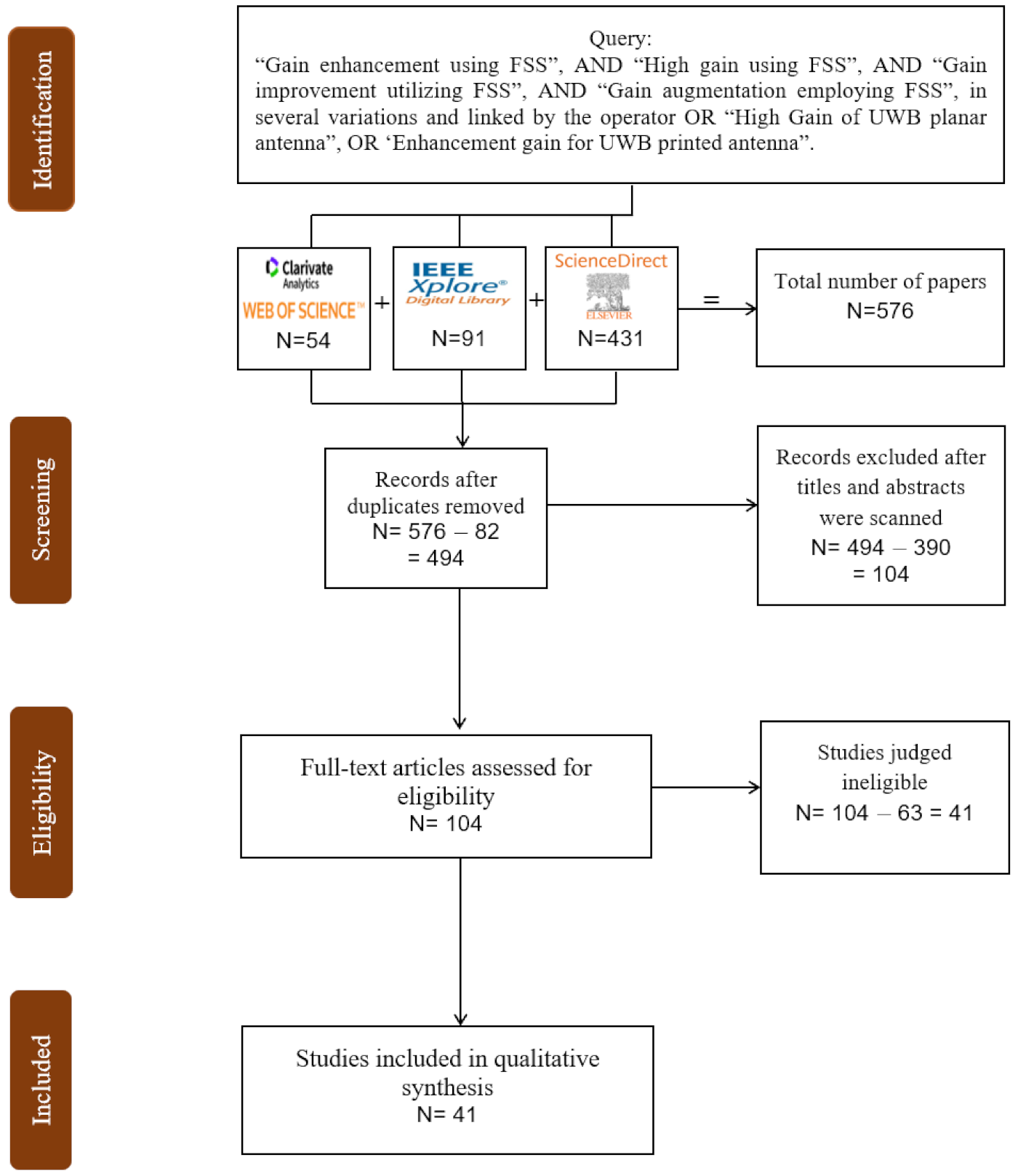
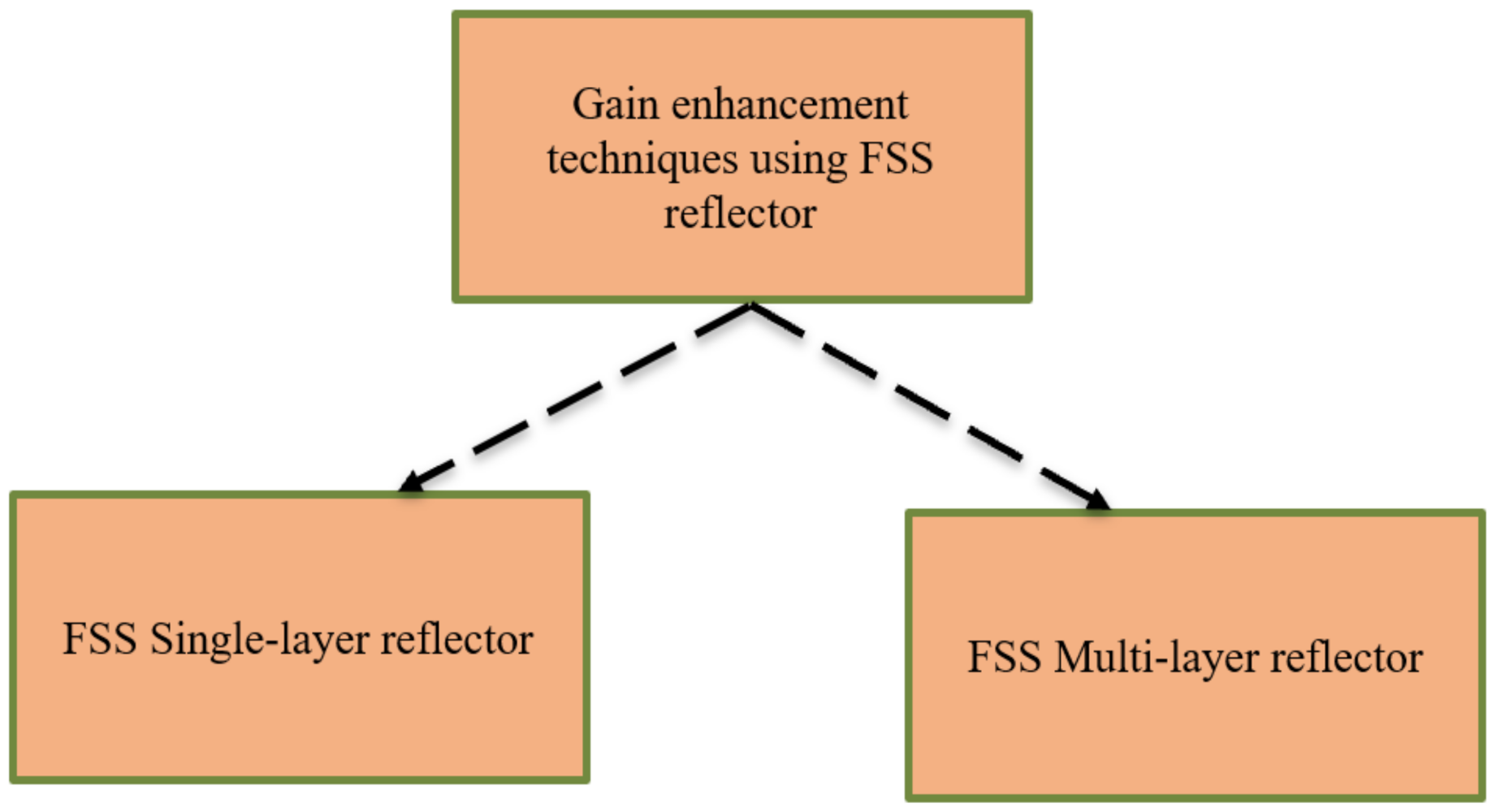
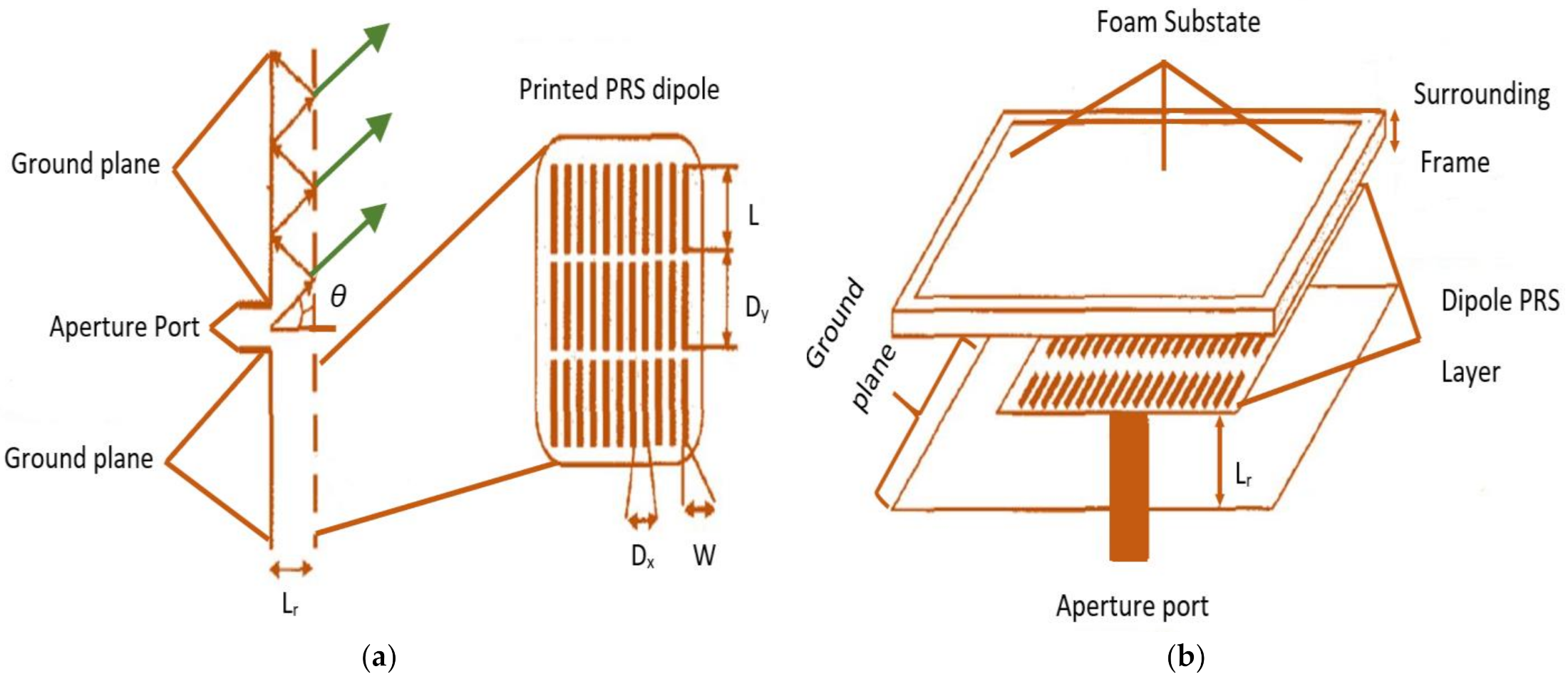
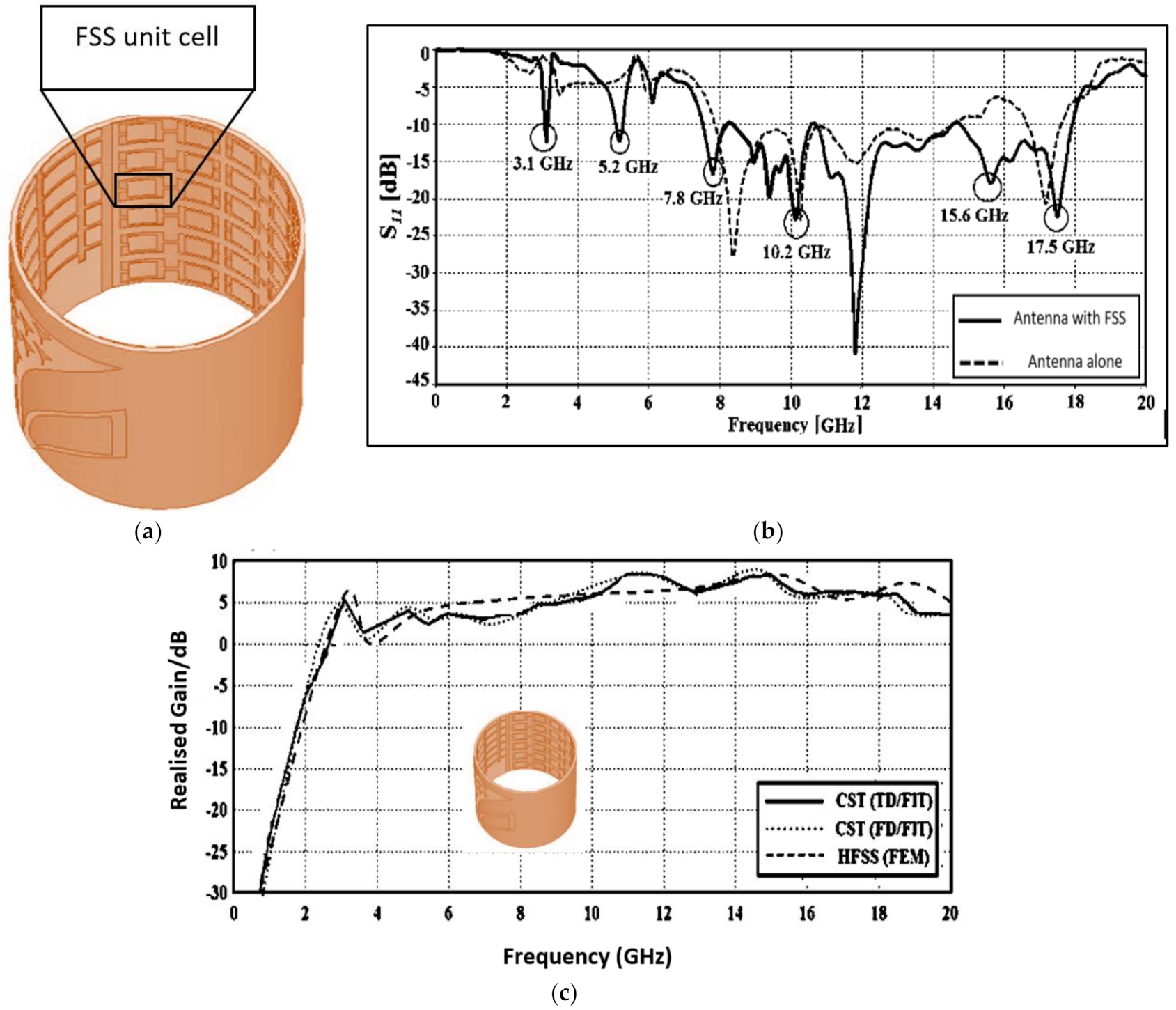

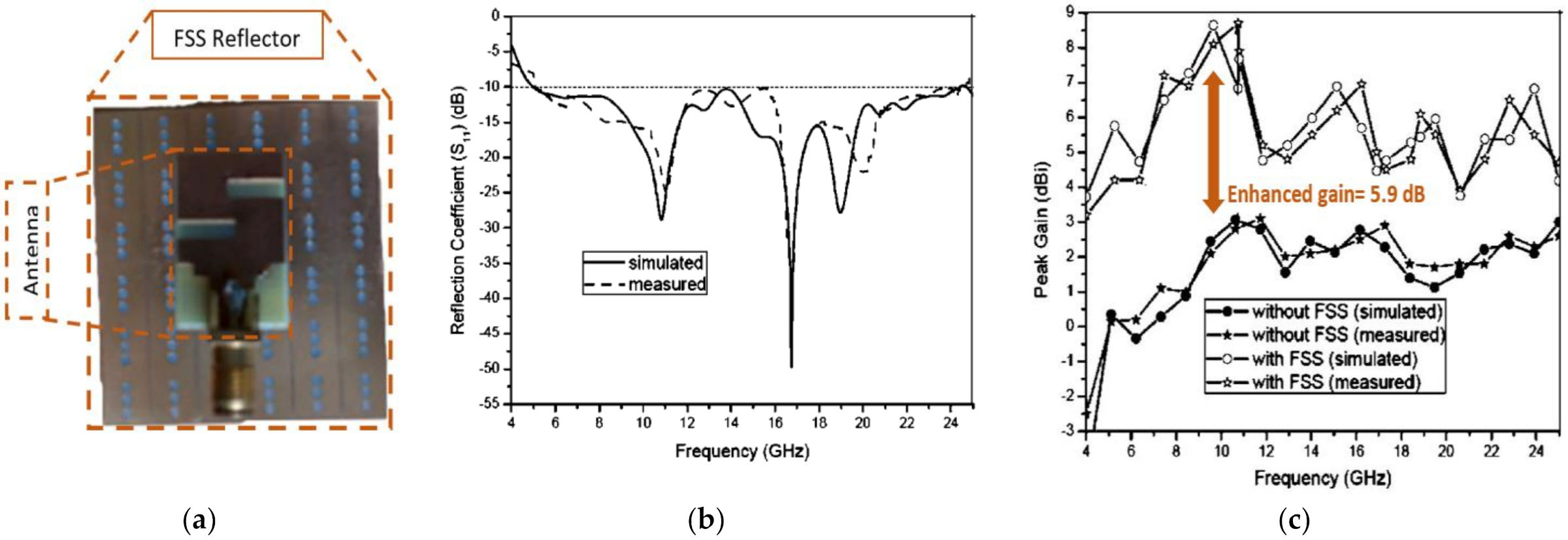

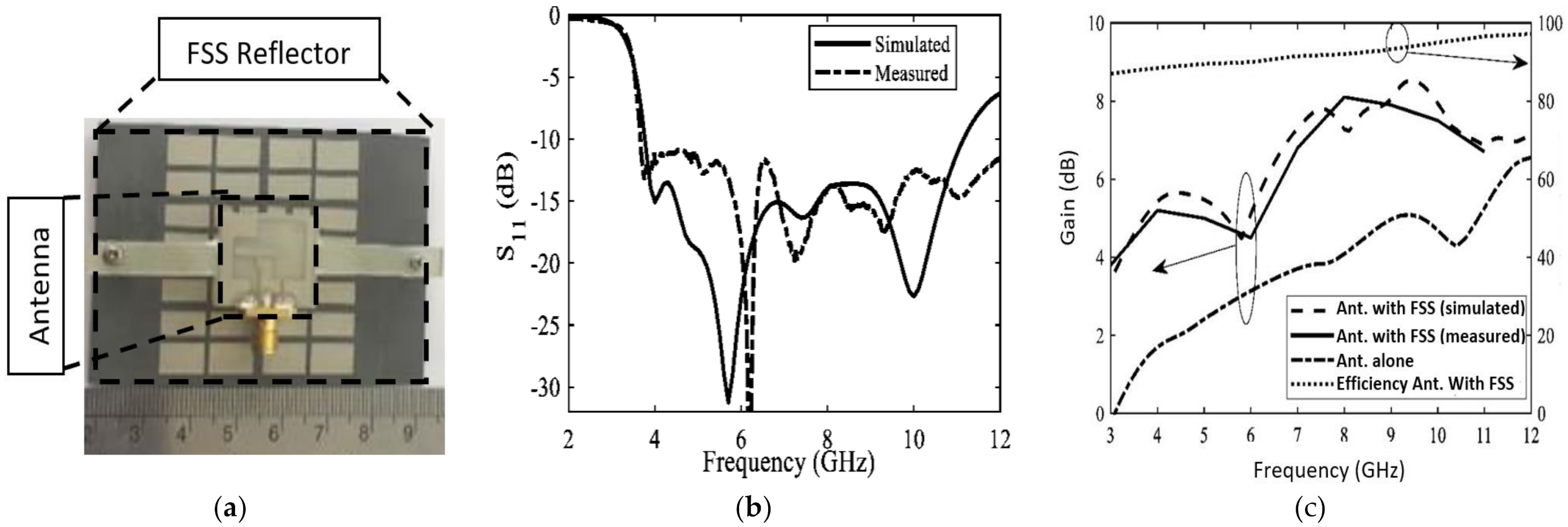
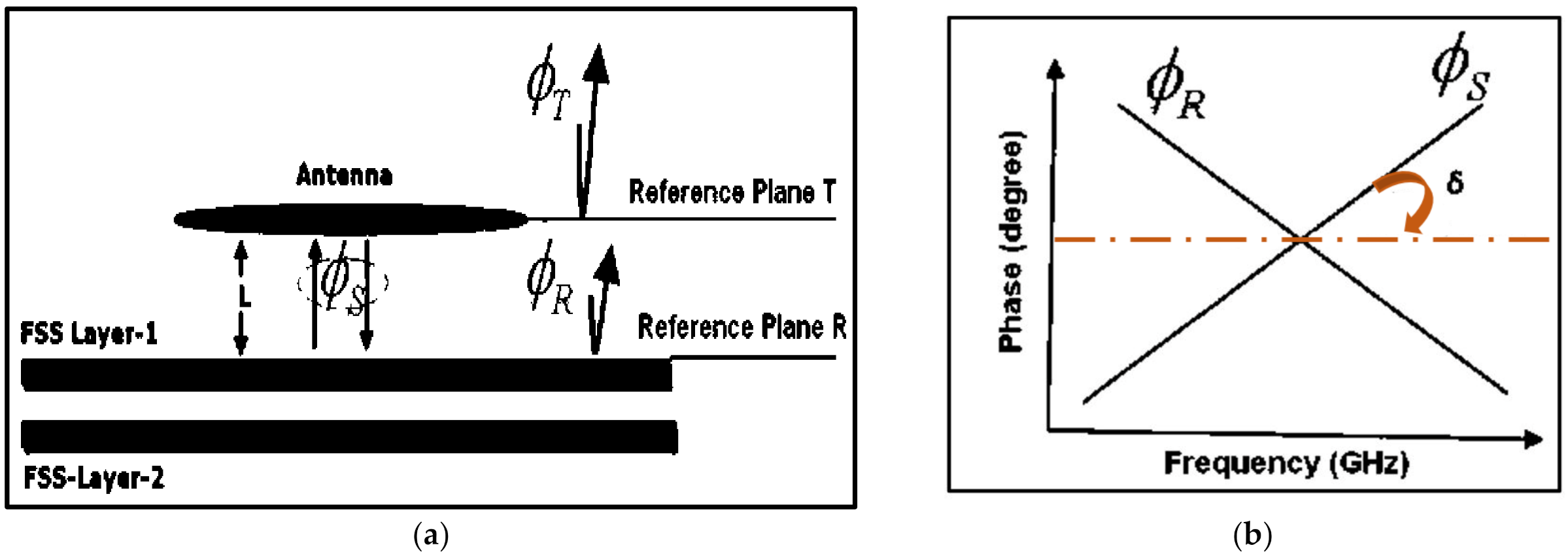


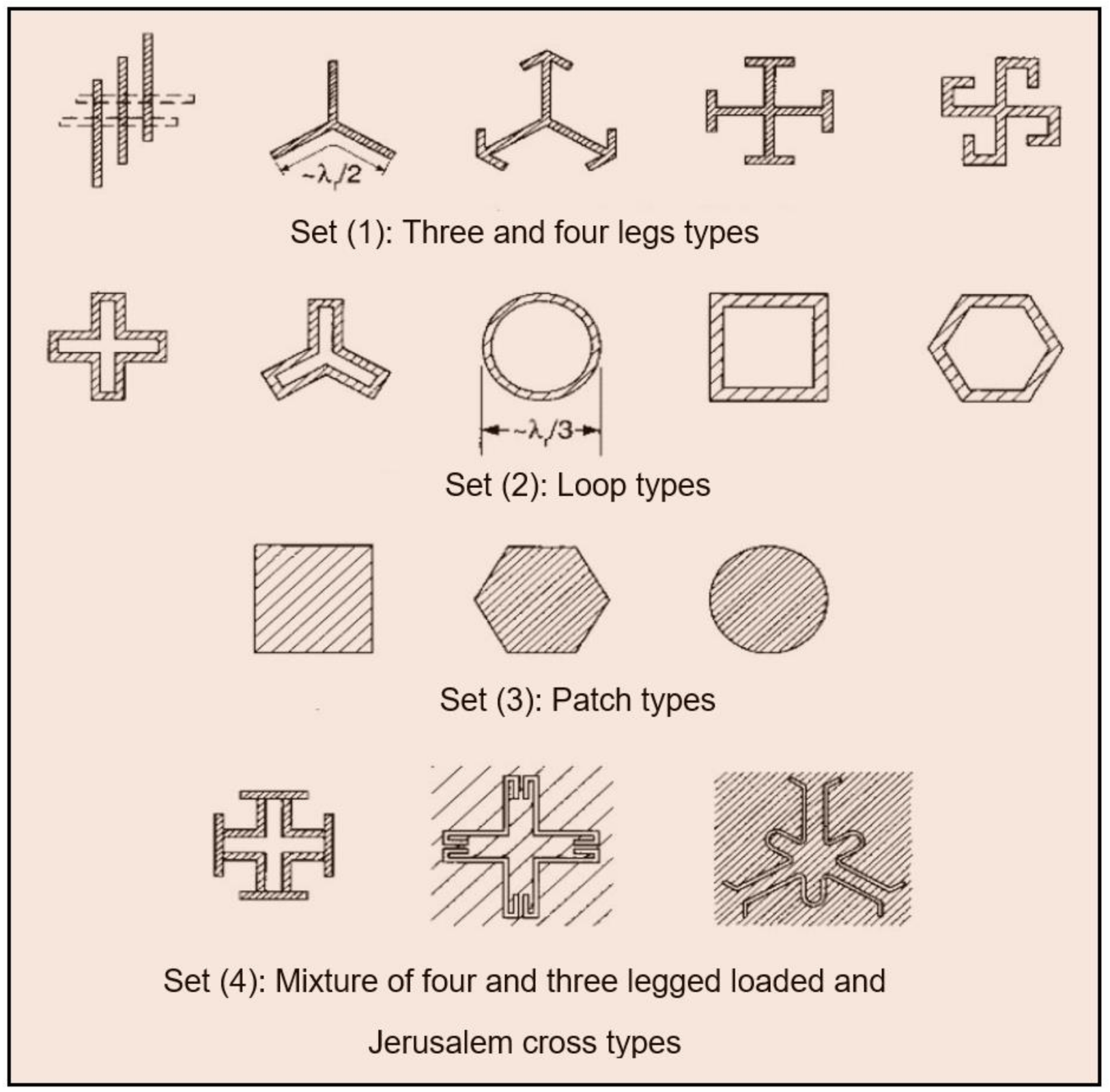
| Digital Library | IEEE Xplore | Web of Science | Science Direct |
|---|---|---|---|
| Periods | Last 10 years | Last 10 years | |
| Language | English | English | |
| Search prototype | Journals and conferences | Journals and conferences | |
| Subject domain | Meta-data | Full manuscript | |
| Date of search | 2021 | 2021 | |
| References | Total Antenna Dimension (mm) | Operating Frequency (GHz) | Peak Gain (dB) | Enhanced Gain (dB) | Number of Reflector Sheets | Dielectric-Layer Type |
|---|---|---|---|---|---|---|
| [37] | 32 × 28 × 32 | 7.8–15 | 6.4 | 3.9 | One | Teflon |
| [38] | 120 × 120 × 30 | 2.07–2.6 | 7.76 | 5.16 | One | Textile |
| [39] | 32 × 32 × 1.6 | 2.7–10.84 | 5 | 3 | One | FR4 |
| [40] | 20 × 20 × 35 | 3.1–10.6 | 6.4 | 2.2 | One | FR4 |
| [42] | 64 × 56 × 18.2 | 3.5–14 | 5 | 4 | One | FR4 |
| [43] | 61 × 61 × 10 | 3.05–11.9 | 9.6 | 6.22 | One | FR4 |
| [44] | 164.24 × 120 × 71.52 | 3–11 | 14.8 | 5.6 | One | FR4 |
| [45] | 52.8 × 52.8 × 18 | 5–24.6 | 8.8 | 5.9 | One | FR4 |
| [48] | 40 × 40 × 13.7 | 2.4–11.2 | 8.5 | 3.5 | One | FR4 |
| [49] | 100 × 100 × 12 | 2.4–11.8 | 5.5 | 3.74 | One | FR4 |
| [50] | 65 × 60 × 20 | 2–20 | 7 | 4 | One | FR4 |
| [51] | 21.6 × 21.6 × 29.6 | 3.8–10.6 | 7.8 | 2 | One | FR4 |
| [52] | 41 × 43 × 25 | 2.82–19.94 | 6.7 | 3.5 | One | FR4 |
| [54] | 35 × 30 × 25 | 2.64–9.36 | 8 | 2 | One | FR4 |
| [55] | 120 × 120 × 16 | 3–12 | 9.2 | 6 | One | FR4 |
| [57] | 20 × 20 × 10 | 3.7–11.1 | 9 | 4 | One | FR4 |
| [59] | 45.8 × 55 × 16 | 2.9–9.3 | 8.12 | 2.9 | One | FR4 |
| [61] | 110 × 110 × 12 | 3–12 | 9.8 | 3.8 | Two | FR4 |
| [63] | 72 × 72 × 10 | 8.6–11.4 | 13.8 | - | Two | Rogers/5880 |
| [64] | 82.5 × 82.5 × 10 | 2.5–11 | 9 | 3.7 | Two | Rogers RO4350B |
| [65] | 35 × 30 × 25 | 3.05–13.4 | 8.5 | 2 | Two | FR4 |
| [66] | 25 × 25 × 9.6 | 4–10 | 8.4 | 5 | Two | FR4 |
| [67] | 85 × 85 × 15 | 2.8–14.2 | 8.9 | 4 | Two | FR4 |
| [68] | 80 × 80 × 15 | 3–6 | 9 | 2-4 | Two | FR4 |
| [69] | 150 × 150 × 12 | 2.9–18.38 | 10.9 | 5 | Two | FR4 |
| [70] | 63 × 63 × 25.7 | 5.5–7 | 12.3 | 2.03 | Three | Gallium Arsenide |
| [71] | 57 × 57 × 1.6 | 4.5–6.5 | 14 | 10 | Two | FR4 |
| [76] | 140 × 140 × 10 | 3–15 | 9.23 | 5.3 | Four | Rogers/5880 |
Publisher’s Note: MDPI stays neutral with regard to jurisdictional claims in published maps and institutional affiliations. |
© 2021 by the authors. Licensee MDPI, Basel, Switzerland. This article is an open access article distributed under the terms and conditions of the Creative Commons Attribution (CC BY) license (https://creativecommons.org/licenses/by/4.0/).
Share and Cite
Al-Gburi, A.J.A.; Ibrahim, I.M.; Zakaria, Z.; Abdulhameed, M.K.; Saeidi, T. Enhancing Gain for UWB Antennas Using FSS: A Systematic Review. Mathematics 2021, 9, 3301. https://doi.org/10.3390/math9243301
Al-Gburi AJA, Ibrahim IM, Zakaria Z, Abdulhameed MK, Saeidi T. Enhancing Gain for UWB Antennas Using FSS: A Systematic Review. Mathematics. 2021; 9(24):3301. https://doi.org/10.3390/math9243301
Chicago/Turabian StyleAl-Gburi, Ahmed Jamal Abdullah, Imran Mohd Ibrahim, Zahriladha Zakaria, Muhannad Kaml Abdulhameed, and Tale Saeidi. 2021. "Enhancing Gain for UWB Antennas Using FSS: A Systematic Review" Mathematics 9, no. 24: 3301. https://doi.org/10.3390/math9243301
APA StyleAl-Gburi, A. J. A., Ibrahim, I. M., Zakaria, Z., Abdulhameed, M. K., & Saeidi, T. (2021). Enhancing Gain for UWB Antennas Using FSS: A Systematic Review. Mathematics, 9(24), 3301. https://doi.org/10.3390/math9243301










